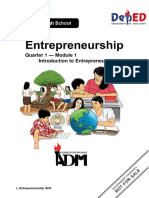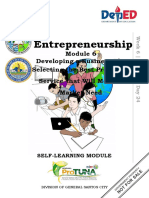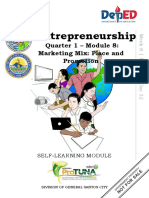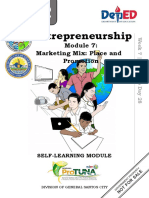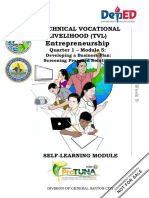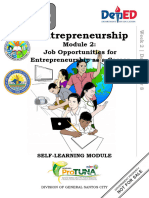Ntrepreneurship: Quarter 1 - Module 3: Developing A Business Plan: Opportunity Spotting
Uploaded by
EDNA DAHANNtrepreneurship: Quarter 1 - Module 3: Developing A Business Plan: Opportunity Spotting
Uploaded by
EDNA DAHAN11/12
Entrepreneurship
Quarter 1 – Module 3:
Developing a Business Plan:
Opportunity Spotting
Week 3
SELF-LEARNING MODULE
DIVISION OF GENERAL SANTOS CITY
Entrepreneurship – Grade 11/12
Self-Learning Module (SLM)
Quarter 1 – Module 3: Developing a Business Plan: Opportunity Spotting
First Edition, 2020
Republic Act 8293, section 176 states that: No copyright shall subsist in any work
of the Government of the Philippines. However, prior approval of the government agency or
office wherein the work is created shall be necessary for exploitation of such work for profit.
Such agency or office may, among other things, impose as a condition the payment of
royalties.
Borrowed materials (i.e., songs, stories, poems, pictures, photos, brand names,
trademarks, etc.) included in this module are owned by their respective copyright holders.
Every effort has been exerted to locate and seek permission to use these materials from
their respective copyright owners. The publisher and authors do not represent nor claim
ownership over them.
Development Team of the Module
Writer: Hilda Emma D. Macaway
Editors: Junrey Villa
Reviewer: Luzviminda R. Loreno, Amalia C. Caballes
Illustrator: Ian Caesar E. Frondoza
Layout Artist: Donabella P. Pagalan
Cover Art Designer: Reggie D. Galindez
Management Team: Romelito G. Flores, CESO V – Schools Division Superintendent
Mario M. Bermudez, CESO VI – Asst. Schools Division
Superintendent
Juliet F. Lastimosa, CID Chief
Sally A. Palomo, EPS - LRMS
Gregorio O. Ruales, EPS – ADM Coordinator
Luzviminda R. Loreno –SHS Coordinator
Amalia C. Caballes – EPS – EPP/TLE/TVL
Printed in the Philippines by Department of Education – General Santos City
Office Address: Tiongson St., Lagao, General Santos City
Telefax: (083) 552-8909
E-mail Address: [email protected]
11/12
Entrepreneurship
Quarter 1 – Module 3:
Developing a Business Plan:
Opportunity Spotting
Week 3
SELF-LEARNING MODULE
DIVISION OF GENERAL SANTOS CITY
Introductory Message
For the facilitator:
Welcome to the Entrepreneurship Self-Learning Module (SLM) on
Developing a Business Plan: Opportunity Spotting!
This module was collaboratively designed, developed and reviewed by
educators both from public and private institutions to assist you, the
teacher or facilitator in helping the learners meet the standards set by
the K to 12 Curriculum while overcoming their personal, social, and
economic constraints in schooling.
This learning resource hopes to engage the learners into guided and
independent learning activities at their own pace and time. Furthermore,
this also aims to help learners acquire the needed 21st century skills
while taking into consideration their needs and circumstances.
In addition to the material in the main text, you will also see this box in
the body of the module:
Notes to the Teacher
This contains helpful tips or strategies that will help you
in guiding the learners.
As a facilitator you are expected to orient the learners on how to use this
module. You also need to keep track of the learners' progress while
allowing them to manage their own learning. Furthermore, you are
expected to encourage and assist the learners as they do the tasks
included in the module.
ii
For the learner:
Welcome to the Entrepreneurship – Grade 11/12 Self-Learning Module
(SLM) on Developing a Business Plan: Opportunity Spotting!
The hand is one of the most symbolized part of the human body. It is
often used to depict skill, action and purpose. Through our hands we
may learn, create and accomplish. Hence, the hand in this learning
resource signifies that you as a learner is capable and empowered to
successfully achieve the relevant competencies and skills at your own
pace and time. Your academic success lies in your own hands!
This module was designed to provide you with fun and meaningful
opportunities for guided and independent learning at your own pace
and time. You will be enabled to process the contents of the learning
resource while being an active learner.
This module has the following parts and corresponding icons:
What I Need to This will give you an idea of the skills or
Know competencies you are expected to learn in
the module.
What I Know This part includes an activity that aims to
check what you already know about the
lesson to take. If you get all the answers
correct (100%), you may decide to skip
this module.
What’s In This is a brief drill or review to help you
link the current lesson with the previous
one.
What’s New In this portion, the new lesson will be
introduced to you in various ways such as
a story, a song, a poem, a problem opener,
an activity or a situation.
What is It This section provides a brief discussion of
the lesson. This aims to help you discover
and understand new concepts and skills.
What’s More This comprises activities for independent
practice to solidify your understanding
and skills of the topic. You may check the
answers to the exercises using the Answer
Key at the end of the module.
What I Have This includes questions or blank
Learned sentence/paragraph to be filled in to
process what you learned from the lesson.
What I Can Do This section provides an activity which will
help you transfer your new knowledge or
skill into real life situations or concerns.
iii
Assessment This is a task which aims to evaluate your
level of mastery in achieving the learning
competency.
Additional In this portion, another activity will be
Activities given to you to enrich your knowledge or
skill of the lesson learned. This also tends
retention of learned concepts.
Answer Key This contains answers to all activities in
the module.
At the end of this module you will also find:
References This is a list of all sources used in
developing this module.
The following are some reminders in using this module:
1. Use the module with care. Do not put unnecessary mark/s on any
part of the module. Use a separate sheet of paper in answering the
exercises.
2. Don’t forget to answer What I Know before moving on to the other
activities included in the module.
3. Read the instruction carefully before doing each task.
4. Observe honesty and integrity in doing the tasks and checking
your answers.
5. Finish the task at hand before proceeding to the next.
6. Return this module to your teacher/facilitator once you are
through with it.
If you encounter any difficulty in answering the tasks in this module, do
not hesitate to consult your teacher or facilitator. Always bear in mind
that you are not alone.
We hope that through this material, you will experience meaningful
learning and gain deep understanding of the relevant competencies. You
can do it!
iv
What I Need to Know
This module was designed and written with you in mind. It is here to help
you master the Development of a Business Plan: Opportunity Spotting. The
scope of this module permits it to be used in many different learning situations. The
language used recognizes the diverse vocabulary level of students. The lessons are
arranged to follow the standard sequence of the course. But the order in which you
read them can be changed to correspond with the textbook you are now using.
This module would assist you as Senior High School learner to recognize a
potential market and analyse a market need (TLE_ICTAN11/12PC-Ia-1).
The module discusses the topic on:
Lesson 1 – Developing a Business Plan: Opportunity Spotting
After going through this module, you are expected to:
1. identify the market problem to be solved;
2. give solution to the problem; and,
3. analyze the market need.
1
What I Know
Let’s begin with challenging our minds about business opportunity spotting.
Are you ready now?
Have I met this before?
Instructions: Read the questions and encircle the letter of your answer.
1. What is that written document describing the nature of the business, the sales and
marketing strategy, financial background and its projected profit and loss
statement?
a. blue print
b. term paper
c. lesson plan
d. business plan
2. What is a business concept?
a. business data
b. financial result
c. business resources
d. a business idea that included basic information
3. What do you do after developing the business concept?
a. hire employees
b. start your business
c. provide the market need
d. incorporate it into a business plan
4. What exist when there is a gap between what is currently on the market and the
possibility for new or significantly improved products that result from emerging
trends?
a. business plan
b. market source
c. marketing plan
d. product opportunity
5. How do we start finding business opportunity?
a. propose solution
b. identify market need
c. create a business plan
d. know the market problem
6. Which of the statement is having a correct idea?
a. Anybody can spot a business opportunity.
b. Only those people with problems can spot opportunity.
c. Spotting business opportunity are only for the wealthy people.
d. Professional entrepreneurs only knows how to spot opportunities.
7. Which of the following target customer have not yet purchased your product but are
considering it?
a. prospects
b. end users
c. existing customers
d. target market users
2
8. Which step should be taken in order to solve a market problem?
a. Concentrate on competition
b. Create solution to compete other industries.
c. Make a solution to solve the problem of the target market.
d. Build innovative solutions that does not directly connect to the problem.
9. Which of the needs in the market that are explicit?
a. wants
b. silent needs
c. stated needs
d. opportunity needs
10. What refers to a cognitive process through which an individual conclude that they
have identified the potential business?
a. business need
b. business opportunity
c. business development
d. opportunity recognition
11. What space in the design thinking process that identifies the problem or
opportunity that motivates the search for solutions?
a. ideation
b. inspiration
c. implementation
d. transformation
12. What space in the design thinking process that leads the project stage into people’s
lives?
a. ideation
b. inspiration
c. implementation
d. transformation
For items 13-15.
Madam Ana uses water from a deep well for drinking and sanitation purposes.
The deep well is situated near a Cement Manufacturing with complete permit and
sanitation. However, she and some of the neighbours experienced stomach problems
from drinking of the water.
13. What is the problem in the community?
a. water system
b. water supply
c. safe drinking water
d. residue of the cement manufacturing
14. What is the solution to the problem?
a. put up a water system
b. find another water source
c. provide safe drinking water
d. close the cement manufacturing
15. What is the market need?
a. sell cement products
b. sell water containers
c. water station for safe drinking water
d. sell industrial materials for water system
3
Lesson
Developing a Business Plan:
1 Opportunity Spotting
Hello dear inspiring Entrepreneur! With the basic concepts you have learned
from the previous lesson, maybe something is already playing in your mind on what
business you wanted to engage in? Probably, at this moment you would be asking
yourself, how should I start? Or, will my idea be patronized by the customers? And a
lot of questions comes into your mind and then you become confused, right?
Preliminary preparations in the business plan writing will be experienced
through the discussion of business opportunities.
What’s In
In order to proceed with the next topic, let’s recall your understanding about
the entrepreneurial key concepts and competencies. Can you recall?
Forget Me Not
Instructions: Read the questions and identify the key concept or common
competencies referred by each statements. Encircle the letter of the correct answer.
1. Which of the statement best describes Entrepreneurship?
a. It is a business venture.
b. It is selling products and services.
c. It is the process of financing a business
d. It is a science of converting ideas into business.
2. What is the desired end of the entrepreneur after processing the product and
services into business?
a. profit
b. capital
c. expenses
d. investment
3. Which of the following core traits that an entrepreneur should possess in order to
direct all subordinates towards the achievement of objectives?
a. leader
b. specialist
c. problem solver
d. good communicator
4
4. Which of the following common traits that an entrepreneur should possess in order
to make bigger ideas that can add value to their existing business?
a. social
b. balanced
c. risk taker
d. innovative
5. Which of the following traits that entrepreneurs should possess in order to attend
to the different challenges in the business environment?
a. social
b. balanced
c. networker
d. problem solver
Notes to the Teacher
Teacher facilitates an activity that enables learners to use previously
taught lesson.
5
What’s New
Now you have learned in the previous lesson about entrepreneurial competencies,
you would be experiencing more about entrepreneurial activities in seeking for
business opportunities.
Activity 1. Read and Get Rich!
Read a part of this article from Eight Successful Filipino Entrepreneurs
Who Started Small and answer the questions that follows.
Tony Tan Caktiong used to operate an
ice cream parlor, before converting it into a
fast food restaurant called Jollibee. With a
starting capital of P350,000.00 the young
Caktiong opened two branches in Cubao and
Quiapo, together with friends who supported
his idea.
Caktiong decided to serve hamburgers,
fried chicken, and spaghetti to customers
when they started looking beyond the usual
ice cream. Eventually, the business grew,
and he had to hire more employees. By
knowing the Filipino market, Jollibee
managed to excel as a fast food powerhouse.
PHOTO BY DAVID PAUL MORRIS/BLOOMBERG
https://www.forbes.com/profile/tony-tan-caktiong/#4348b4231a25
Processing Questions:
Instruction: Write your answer on the space provided.
1. What is the business of Tony Tan Caktiong?
______________________________________________________________________________
______________________________________________________________________________
______________________________________________________________________________
2. What is his original business idea? Is the original business idea of Tony became
successful? Why?
______________________________________________________________________________
______________________________________________________________________________
______________________________________________________________________________
6
3. What are the steps that he did in order to come-up with a successful business?
______________________________________________________________________________
______________________________________________________________________________
______________________________________________________________________________
4. What lesson in the story that could help us become successful entrepreneurs?
______________________________________________________________________________
______________________________________________________________________________
______________________________________________________________________________
Activity 2. Find the Path!
Finding problems and giving solutions will help open our minds into
different business ideas. Here is an activity to help in practicing our mind to open
into different opportunities.
Instruction: Read the situation below and fill the matrix with answers.
The role of an entrepreneur is extraordinary specially in the providing the
needs of the community. Presently, the country/world is experiencing crisis in the
health sector specifically due to the COVID 19 pandemic which has a domino effect
in all other sectors of the community.
As an entrepreneur think of 3 probable problems and business solutions to
attend to the situation.
Problem Solution Need
1.
2.
3.
7
After doing so, arrange the need according to priority and give the reason for
its order. Giving priorities would mean the first is the most essential solution.
Order of Priority Need Reason
First Priority
Second Priority
Third Priority
8
What is It
Your activity is a test of becoming an entrepreneur. Seeing beyond the box
is a need to create and innovate resources. The problem is how to begin with
putting up the idea?
Some would say start with a business plan, but what is a business plan?
Business Plan is written document describing the nature of the business,
the sales and marketing strategy, and the financial background, and containing a
projected profit and loss statement.
Some people think you don't need a business plan unless you're trying to
borrow money. But a business plan is more than a pitch for financing; it's a guide
to help you define and meet your business goals.
A business plan won't automatically make you a success, but it will help you
avoid some common causes of business failure, such as under-capitalization or
lack of an adequate market.
One could not write a business plan without going into the first process
which is looking into the business concept.
Business concept is an idea for a business that includes basic information
such as the service or product, the target demographic, and a unique selling
proposition that gives a company an advantage over competitors. A business
concept may involve a new product or simply a novel approach to marketing or
delivering an existing product. Once a concept is developed, it is incorporated into a
business plan.
To bring about the business concept, the entrepreneur should be able to
recognize an opportunity in terms of product or services.
Product Opportunity exist when there is a gap between what is currently
on the market and the possibility for new or significantly improved products that
result to emerging trends.
Opportunity recognition is relevant to an entrepreneur, it is the active,
cognitive process (or processes) through which individuals conclude that they have
identified the potential to create something new that has the potential to generate
economic value and that is not currently being exploited or developed, and is
viewed as desirable in the society in which it occurs (i.e. its development is
consistent with existing legal and moral conditions
People might be wondering how entrepreneurs come up with potential
products. Systematic innovation involves “monitoring seven sources for
innovative opportunity” (Drucker, 1985, p. 35). The first four are internally
focused within the business or industry, in that they may be visible to those
involved in that organization or sector. The last three involve changes outside the
business or industry.
9
Internally Focused
o The unexpected (unexpected success, failure, or outside events). An
entrepreneur may be able to discover opportunity such as in failures like
overproduction of fresh tomatoes thus the entrepreneur was able to preserve
tomatoes through drying or boiling.
o The incongruity between reality as it actually is and reality as it is assumed to
be or as it ought to be. Children doesn’t choose vegetables over meat but now
in reality entrepreneurs are making ways that children will love vegie foods
like shawarma, vegie dumplings and the like.
o Innovation based on process need. In the pandemic times, medical face mask
become scarce to cope with the need, entrepreneurs provided reusable facemask
for nonmedical practitioners.
o Changes in industry structure or market structure that catch everyone
unawares. The market competition becomes an opportunity like the popping
up of convenience stores which grew like mushrooms around the city blocks.
Externally Focused
o Demographics (population changes). Like age, status, race, sex is an
entrepreneurial bases for opportunity for each factor needs to be considered in
providing goods and services.
o Changes in perception, mood, and meaning. The uniqueness of every
individual creates differentiation of the offered goods and services like the choice of
perfume scents.
o New knowledge, both scientific and non-scientific. Acquired information both
from scientific or in non-scientific way can easily get into the ideas of an
entrepreneur. ,
Entrepreneurs discover opportunities when they search for them in existing
markets. This means they observe technological, economic or social trends.
Recognizing opportunities is a cognitive process. It relies on the ability of people to
recognize patterns and connect the dots.
Entrepreneurs create opportunities when they engage with others in
bouncing ideas back and forth, and each time it becomes more specific what the
user needs are and how they are going to be solved. Creating opportunities is a
social process. It relies on the ability of entrepreneurs to interact.
There are two ways to recognize opportunities: discovering or creating.
It is up to you as an entrepreneur which way is most suitable for you and which
actions to take to enable opportunity recognition.
Design thinking is a human-centered approach to innovation that draws
from the designer’s toolkit to integrate the needs of people, the possibilities of
technology, and the requirements for business success – Tim Brown, president and
CEO.
The design thinking process is best thought of as a system of overlapping
spaces rather than a sequence of orderly steps. There are three spaces to keep in
mind: inspiration, ideation, and implementation. Inspiration is the problem or
opportunity that motivates the search for solutions. Ideation is the process of
generating, developing, and testing ideas. Implementation is the path that leads
from the project stage into people’s lives.
10
To deliver products that solve your target customers’ problems, you must
first identify market problems. These problems may be stated directly as
customer needs or implied indirectly.
Stated needs are explicit statements from your market that declare, “I want
a product to do X.” While stated needs are important, they are not as powerful as
silent needs, which are problems with as yet undefined solutions.
Your market consists of: Existing customers: People who have already
purchased your product; Prospects: People who have not yet purchased your
product but are considering it and, Target market users: People in your target
market who are not currently looking for a solution.
The key is to balance your focus to ensure that you are really listening to
your entire market at the same time. Key factors in order to make solutions to the
problems: Don’t focusing only on innovation and the competition, focus in
solving the problem. Don’t focus only on customers. Customers understand
problems, but they cannot help you to move your product forward. They know what
you provide, and tend to stay inside that mindset. Don’t Focus only on revenue. It
is critical to find a balance between prospects and customers to ensure that your
future revenue is protected, while still keeping existing customers happy.
Spotting Business Opportunities. Anyone can spot the opportunities either
by watching others having a problem or find a solution to their own problem which
many others may also be facing.
Observation skills and keeping an ear to the ground are traits of successful
entrepreneurs. Spotting an opportunity is the only first step but to convert the idea
to a business requires good execution skills.
The opportunity should also have sufficient market. If the market already
has similar products / services, how can one differentiate their product from others
will determine whether opportunity becomes a reality. Business opportunities are
like buses. If you miss one, there is always another one.
11
What I Have
What’s More Learned
Now, let’s try to transmit what you have read on the discussion by answering
the questions below.
Activity 3. Screening time!
Instruction: Read the questions and write your answers on the space provided.
1. What is business/product opportunity?
__________________________________________________________________________________
__________________________________________________________________________________
__________________________________________________________________________________
2. Why is business/product opportunity spotting important in the making of the
business plan?
__________________________________________________________________________________
__________________________________________________________________________________
__________________________________________________________________________________
3. How do we start finding business opportunity?
__________________________________________________________________________________
__________________________________________________________________________________
__________________________________________________________________________________
4. How can we find a market need?
__________________________________________________________________________________
__________________________________________________________________________________
__________________________________________________________________________________
5. What are the sources of opportunity?
__________________________________________________________________________________
__________________________________________________________________________________
__________________________________________________________________________________
6. What is the significance of knowing the sources of opportunities?
__________________________________________________________________________________
__________________________________________________________________________________
__________________________________________________________________________________
12
It’s time to connect the learnings into one. Fill the space with word(s) to
complete our learning for this module.
1. To spot an opportunity is to find the ______________________.
2. To identify the market need is to make the ____________________ to the problem.
3. To identify business opportunity is to know the ____________________.
4. To make sure that the spotted opportunity will be delivered, the entrepreneur
should identify the __________________.
13
Assessment
What I Can Do
As an Entrepreneur, you will be challenged to find business opportunities in
your community and this activity would lead you to improve your skills in
opportunity spotting.
Activity 4: Dig the Gold
Identify a market problem in the community where your residence is located and
give solution to the problem which would lead to discovering your opportunity in
business.
Fill in the form for this will serve as basis for business proposal.
Business
Problem Solution Market Need Target Market
Opportunity
Congratulations! You have acquired now the learning in this module. Below
is a test to be given for you to recognize what you have learned in this module.
14
Instructions: Read the questions and encircle the letter of your answer.
1. What is that written document describing the nature of the business, the sales and
marketing strategy, financial background and its projected profit and loss
statement?
a. blue print
b. term paper
c. lesson plan
d. business plan
2. What is a business concept?
a. business data
b. financial result
c. business resources
d. a business idea that included basic information
3. What do you do after developing the business concept?
a. hire employees
b. start your business
c. provide the market need
d. incorporate it into a business plan
4. What exist when there is a gap between what is currently on the market and the
possibility for new or significantly improved products that result from emerging
trends?
a. business plan
b. market source
c. marketing plan
d. product opportunity
5. How do we start finding business opportunity?
a. propose solution
b. identify market need
c. create a business plan
d. know the market problem
6. Which of the statement is having a correct idea?
a. Anybody can spot a business opportunity.
b. Only those people with problems can spot opportunity.
c. Spotting business opportunity are only for the wealthy people.
d. Professional entrepreneurs only knows how to spot opportunities.
7. Which of the following target customer have not yet purchased your product but are
considering it?
a. prospects
b. end users
c. existing customers
d. target market users
8. Which step should be taken in order to solve a market problem?
a. Concentrate on competition
b. Create solution to compete other industries.
c. Make a solution to solve the problem of the target market.
d. Build innovative solutions that does not directly connect to the problem.
15
9. Which of the needs in the market that are explicit?
a. wants
b. silent needs
c. stated needs
d. opportunity needs
10. What refers to a cognitive process through which an individual conclude that they
have identified the potential business?
a. business need
b. business opportunity
c. business development
d. opportunity recognition
11. What space in the design thinking process that identifies the problem or
opportunity that motivates the search for solutions?
a. ideation
b. inspiration
c. implementation
d. transformation
12. What space in the design thinking process that leads the project stage into people’s
lives?
a. ideation
b. inspiration
c. implementation
d. transformation
For items 13-15.
Mang Tomi is a farmer who plants vegetables and spices. He planted more
tomatoes due to the demand of the market. Tomatoes are highly perishable and
other neighboring regions also grow their own tomatoes. Unexpectedly, a down shift
on the demand due to competition of different tomato growers came before the
harvest. Market price of the tomatoes decreases due to overproduction of the
farmers and consumers in their community only uses tomatoes for food
consumption.
13. What is the problem of the community?
a. low demand c. many competition
b. overproduction d. bad quality of tomatoes
14. What is the solution to the problem?
a. sell at breakeven price c. give the tomatoes for free
b. throw the excess tomatoes d. make other products out of tomatoes
15. What is the market need?
a. exportation c. tomatoes for consumption
b. retailing of tomatoes d. wholesale for tomatoes
16
Additional Activities
Congratulations again! You made it up to the end of this module then you
are ready for the next step. But for you to be prepared for the next module, think
of a product or service that you can propose for the business based on your spotted
business opportunity.
Instruction: Write your proposed idea based on the matrix below and post a sample
picture of a similar product or service you wanted to offer.
What business am I What is the purpose of Who are my target
interested to engage? my business? customers?
Sample Picture
Suggested Rubrics for checking:
10-9 8-7 6-5 4-3 2-1 Total
CRITERIA Excellent Very Good Good Fair Poor Points
Completeness of the task
required
Relevance of the Content
Image Quality
TOTAL POINTS
17
18 WHAT’S NEW…
What's In Activity 1
What I Know 1. Jollibee
1. D 9. C 1. D 2. His original business idea is an Ice
2. D 10. D 2. A cream parlor. No, because he
3. D 11. B 3. A converted the idea into a restaurant
4. D 12. C 4. D which would mean there is a need to
5. D 13. C 5. B improve his business.
6. A 14. C 3. The steps that he do to come-up with
7. A 15. C a successful business are:
8. C He asked his friends support
about his business idea.
He came to know the Filipino
market.
Management of resources.
4. (Different ideas/opinions from
students based from the article.
WHAT’S NEW…
Activity 2
Sample answers:
Problem Solution Need
1. Health problems Prevent illnesses Medicine
Vaccine
2. Limited income Augmentation of Acceptable business side line
Family income
3. Slow business Transportation of Mobilization of goods at different
movement goods modalities
Arrange the need according to priority and give the reason for its order.
Order of Priority Need Reason
First Priority Medicine To be safe and have a normal life
Vaccine movement
Second Priority Mobilization of People need goods and services for their
goods at different daily life consumption
modalities
Third Priority Acceptable business Placed on the last for most have their
side line fix income and some received subsidy
from the government.
Answer Key
WHAT’S MORE…
What is business/product opportunity?
Product Opportunity exist when there is a gap between what is currently on
the market and the possibility for new or significantly improved products that result
to emerging trends.
Why is business/product opportunity spotting important in the making of the
business plan?
A business concept may involve a new product or simply a novel approach to
marketing or delivering an existing product. Once a concept is developed, it is
incorporated into a business plan.
How do we start finding business opportunity?
Entrepreneurs discover opportunities when they search for them in existing
markets. This means they observe technological, economic or social trends.
Recognizing opportunities is a cognitive process. It relies on the ability of people to
recognize patterns and connect the dots.
Entrepreneurs create opportunities when they engage with others in bouncing
ideas back and forth, and each time it becomes more specific what the user needs
are and how they are going to be solved. Creating opportunities is a social process. It
relies on the ability of entrepreneurs to interact.
How can we find a market need?
To deliver products that solve your target customers’ problems, you must first
identify market problems. These problems may be stated directly as customer
needs or implied indirectly
How can we find a market need?
To deliver products that solve your target customers’ problems, you must first
identify market problems. These problems may be stated directly as customer
needs or implied indirectly
What are the sources of opportunity?
Internally Focused
o The unexpected (unexpected success, failure, or outside events)
o The incongruity between reality as it actually is and reality as it is assumed to
be or as it ought to be
o Innovation based on process need
o Changes in industry structure or market structure that catch everyone
unawares
Externally Focused
o Demographics (population changes)
o Changes in perception, mood, and meaning
o New knowledge, both scientific and non-scientific
What is the significance of knowing the sources of opportunities?
Entrepreneurs discover opportunities when they search for them in existing
markets. This means they observe technological, economic or social trends.
Recognizing opportunities is a cognitive process. It relies on the ability of people to
recognize patterns and connect the dots.
19
20
WHAT I HAVE LEARNED…
1. Problem
2. Solution
3. Market Need
4. Target market
WHAT I CAN DO…
Sample answers
Business
Problem Solution Market Need Target market
Opportunity
No fresh Supply fresh Provide outlet Make a stall Adults
vegetables in vegetables that sells or shop for
the market fresh fresh Vegetarian
vegetables vegetables
Health
conscious
customers
ASSESSMENT…
1. D 9. C
2. D 10. D
3. D 11. B
4. D 12. C
5. D 13. B
6. A 14. D
7. A 15. C
8. C
References
Business Plan. Retrieved from
http://www.entrepreneur.com/encyclopedia/business-plan
Spotting Business Opportunities. Retrieved from
https://www.10minutebiztools.com/Spotting-Business-Opportunities.html
Stull, C., Myers, P.& Scott D.M. (2008). Identifying Market Problems: building
Products to Meet Customer Needs. https://learn.marsdd.com/article/identifying-
market-problems/
Swanson, Lee A. (2017) Entrepreneurship and Innovation Toolkit. Retrieved from
https://openpress.usask.ca/entrepreneurshipandinnovationtoolkit/chapter/chapt
er-1-introduction-to-entrepreneurship/
Chehtman, Andres (2017, July 27). 8 Ways to Identify Market Opportunities for
Business Growth. Retrieved from https://blog.euromonitor.com/8-ways-identify-
market-opportunities-business-growth/ar
Cagan, Jonathan; Vogel’ Craig M. (2012, September 13). What Drives New Product
Development. Retrieved from
https://www.informit.com/articles/article.aspx?p=1945330&seqNum=2
Eight Successful Filipino Entrepreneurs Who Started Small. (2019, July 5)
Retrieved from https://business.inquirer.net/273445/eight-successful-filipino-
entrepreneurs-who-started-small
Morris/Bloomberg, David Paul. Retrieved from
https://www.forbes.com/profile/tony-tan-caktiong/#4348b4231a25
21
DISCLAIMER
This Self-learning Module (SLM) was developed by DepEd – Division of
General Santos City with the primary objective of preparing for and
addressing the new normal. Contents of this module were based on DepEd’s
Most Essential Learning Competencies (MELC). This is a supplementary
material to be used by all learners in General Santos City in all public
schools beginning SY 2020-2021. The process of LR development was
observed in the production of this module. This is version 1.0. We highly
encourage feedback, comments, and recommendations.
For inquiries or feedback, please write or call:
Department of Education – Division of General Santos City
Learning Resource Management System (LRMS)
Tiongson St., Lagao, General Santos City
Telefax No.: (083) 552-8909
Email Address: [email protected]
22
You might also like
- Complete Answer Guide for Computer Networking A Top-Down Approach 6th Edition Kurose Solutions Manual100% (19)Complete Answer Guide for Computer Networking A Top-Down Approach 6th Edition Kurose Solutions Manual32 pages
- Entrepreneurship: Quarter 2 - Module 1: The 4Ms of Operations50% (2)Entrepreneurship: Quarter 2 - Module 1: The 4Ms of Operations24 pages
- Entrepreneurship Module 3 - Developing Business Plan93% (15)Entrepreneurship Module 3 - Developing Business Plan32 pages
- Quarter 1 Module 2 Recognize A Potential Market100% (12)Quarter 1 Module 2 Recognize A Potential Market30 pages
- Entrepreneurship: Quarter 2 - Module 5: Developing A Business Model100% (5)Entrepreneurship: Quarter 2 - Module 5: Developing A Business Model26 pages
- Entrep12 - q1 - m3 - Recognize and Understand The Market87% (47)Entrep12 - q1 - m3 - Recognize and Understand The Market21 pages
- Entrep12 q1 m1 Introduction-To-Entrepreneurship100% (1)Entrep12 q1 m1 Introduction-To-Entrepreneurship18 pages
- Entrepreneurship: Quarter 1 - Module 9: People, Packaging, Position100% (2)Entrepreneurship: Quarter 1 - Module 9: People, Packaging, Position36 pages
- Ntrepreneurship: Quarter 1 - Module 4: Developing A Business Plan: Identifying The Market Need100% (3)Ntrepreneurship: Quarter 1 - Module 4: Developing A Business Plan: Identifying The Market Need34 pages
- Signed-Off EntrepreneurshipG12 q2 - Mod6 4msproduction Busmodel v393% (15)Signed-Off EntrepreneurshipG12 q2 - Mod6 4msproduction Busmodel v324 pages
- Module 3 7Ps of Marketing Mix and Branding100% (1)Module 3 7Ps of Marketing Mix and Branding31 pages
- Entrepreneurship: Quarter 1 - Module 3: Developing A Business Plan100% (7)Entrepreneurship: Quarter 1 - Module 3: Developing A Business Plan32 pages
- Purvi Enterprises: Detailed Project ReportNo ratings yetPurvi Enterprises: Detailed Project Report19 pages
- Entrepreneurship: Quarter 1 - Module 5: Developing A Business Plan: Screening Proposed Solutions86% (7)Entrepreneurship: Quarter 1 - Module 5: Developing A Business Plan: Screening Proposed Solutions33 pages
- Entrepreneurship: Quarter 1 - Module 7: 1. Branding 2. The Business Plan100% (1)Entrepreneurship: Quarter 1 - Module 7: 1. Branding 2. The Business Plan27 pages
- Entrepreneurship: Quarter 1 - Module 8: Marketing Mix: Place and Promotion100% (1)Entrepreneurship: Quarter 1 - Module 8: Marketing Mix: Place and Promotion38 pages
- Entrep12q1m3recognize and Understand The Market100% (2)Entrep12q1m3recognize and Understand The Market20 pages
- Entrepreneurship: Quarter 1 - Module 1: Relevance of The Course100% (6)Entrepreneurship: Quarter 1 - Module 1: Relevance of The Course24 pages
- Entrep12 q1 m2 Recognize A Potential Market89% (9)Entrep12 q1 m2 Recognize A Potential Market20 pages
- Entrepreneurship: Quarter 1 - Module 5 7 P's of Marketing and Branding100% (1)Entrepreneurship: Quarter 1 - Module 5 7 P's of Marketing and Branding28 pages
- Entrepreneurship: Quarter 1 - Module 10: Develop A Brand Name100% (1)Entrepreneurship: Quarter 1 - Module 10: Develop A Brand Name36 pages
- Q2 - Entrep Module 3, Week 3revised2final Wih Answer Keys63% (8)Q2 - Entrep Module 3, Week 3revised2final Wih Answer Keys19 pages
- Quarter 2 - Module 4 Performing Bookkeeping Tasks: Entrepreneurship100% (4)Quarter 2 - Module 4 Performing Bookkeeping Tasks: Entrepreneurship15 pages
- ABM-ENTERPRENUERSHIP 12 - Q1 - W4 - Mod4 PDF86% (21)ABM-ENTERPRENUERSHIP 12 - Q1 - W4 - Mod4 PDF15 pages
- Wk-2-Entrepreneurship G12 Module LAS and WHLP100% (1)Wk-2-Entrepreneurship G12 Module LAS and WHLP2 pages
- Entrepreneurship: Quarter 1 Week 3 Module 333% (3)Entrepreneurship: Quarter 1 Week 3 Module 313 pages
- Entrepreneurship: Quarter 1 - Module 1: Key Components and Relevance of Entrepreneurship100% (1)Entrepreneurship: Quarter 1 - Module 1: Key Components and Relevance of Entrepreneurship28 pages
- Entrepreneurship: Quarter 1 - Module 1-Lesson 1: Relevance of The Course83% (6)Entrepreneurship: Quarter 1 - Module 1-Lesson 1: Relevance of The Course16 pages
- Entrep12 q1 m5 7p S of Marketing and BrandingNo ratings yetEntrep12 q1 m5 7p S of Marketing and Branding36 pages
- Entrepreneurship: Quarter 2 - Module 9 Business Implementation71% (7)Entrepreneurship: Quarter 2 - Module 9 Business Implementation10 pages
- Entrepreneurship12 q2 Mod2 Starting and Operating A Simple Business100% (3)Entrepreneurship12 q2 Mod2 Starting and Operating A Simple Business24 pages
- Entrepreneurship: Quarter 2 - Module 3 4Ms of OperationsNo ratings yetEntrepreneurship: Quarter 2 - Module 3 4Ms of Operations9 pages
- Entrepreneurship12q1 Mod5 7P's of Marketing and Branding v388% (24)Entrepreneurship12q1 Mod5 7P's of Marketing and Branding v334 pages
- Entrep12 Mod1 Introduction-to-Entrepreneurship v2100% (2)Entrep12 Mod1 Introduction-to-Entrepreneurship v213 pages
- Applied - 1112 - Entrepreneurship - q3 - CLAS4 - Screening The Proposed Solution Based On Viability - v3 1 JOSEPH AURELLO100% (1)Applied - 1112 - Entrepreneurship - q3 - CLAS4 - Screening The Proposed Solution Based On Viability - v3 1 JOSEPH AURELLO17 pages
- Entrepreneurship 11 12 Q1 Week3 Week6 MELC03 MELC05 MOD Baloaloa, JeffersonNo ratings yetEntrepreneurship 11 12 Q1 Week3 Week6 MELC03 MELC05 MOD Baloaloa, Jefferson49 pages
- Five Attitudes of Effective Teachers - Implications For Teacher TrainingNo ratings yetFive Attitudes of Effective Teachers - Implications For Teacher Training10 pages
- 100 Ton 3 Axle Tipper Trailer-TITAN QuotationNo ratings yet100 Ton 3 Axle Tipper Trailer-TITAN Quotation6 pages
- The Demonizing Representation of Cosplaying in The Case of NamiNo ratings yetThe Demonizing Representation of Cosplaying in The Case of Nami20 pages
- NIST Security Models: NIST Special Publication SP 800-12No ratings yetNIST Security Models: NIST Special Publication SP 800-122 pages
- INTERNATIONAL CASE STUDY ON Art and Culture MuseumNo ratings yetINTERNATIONAL CASE STUDY ON Art and Culture Museum61 pages
- Full download (Ebook) Nuclear Medicine and PET/CT Cases (Cases in Radiology) by Chun K. Kim ISBN 9780199773695, 0199773696 pdf docxNo ratings yetFull download (Ebook) Nuclear Medicine and PET/CT Cases (Cases in Radiology) by Chun K. Kim ISBN 9780199773695, 0199773696 pdf docx86 pages
- JCM - ID - AM013 - Ver01.0 - Solar Power Plant MethodologyNo ratings yetJCM - ID - AM013 - Ver01.0 - Solar Power Plant Methodology7 pages
- Biafra: Why Igbo Want To Secede: Arabian Journal of Business and Management Review (Nigerian Chapter)No ratings yetBiafra: Why Igbo Want To Secede: Arabian Journal of Business and Management Review (Nigerian Chapter)9 pages







